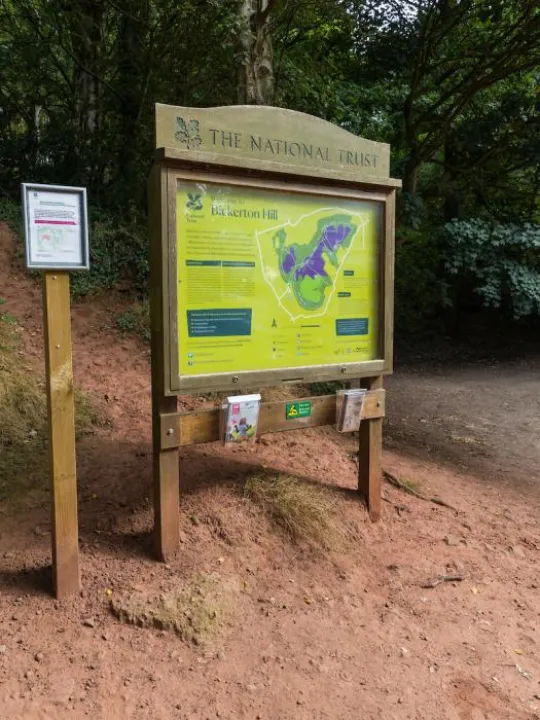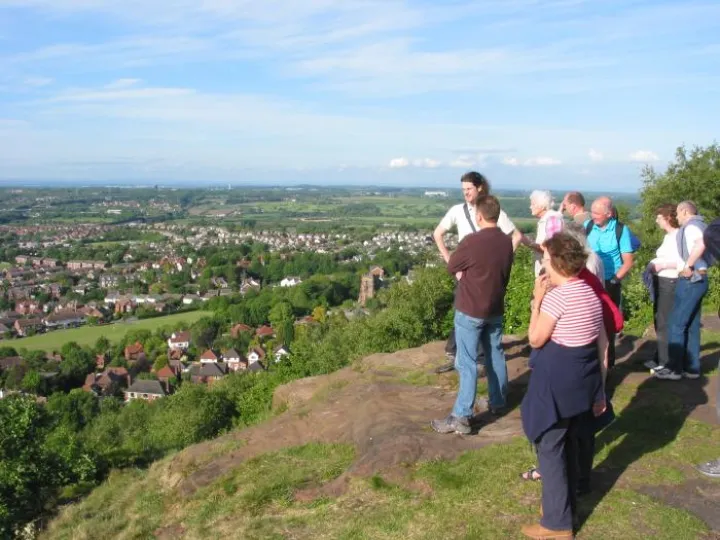National Trust
The National Trust is the largest conservation organisation in the United Kingdom, looking after over 350 historic properties as well as 350,000 hectares of land, and with over 4 million members. Three of its popular countryside properties lie along the Sandstone Ridge: Helsby Hill, Bulkeley Hill and Bickerton Hill.
Helsby Hill overlooks the village of Helsby at the northern end of the Ridge, providing panoramic views across the broad Mersey Valley to Liverpool. There are also fine views east to Woodhouse Hill. The summit itself includes an Iron Age hillfort constructed sometime between 800 and 400 BC. The steep slopes on the northern and western sides provide a natural semi-circular defence. Once open heath and grazed, the hillsides are now clothed with semi-natural birch and oak woodland.
The summit is a popular destination for visitors; and the crags, which are thought to provide some of the most challenging climbs in the region, are believed to have provided a training site for the young George Mallory before his ill-fated attempt on Everest in 1924.
Bulkeley Hill forms the southern end of the Peckforton Hills. This 35 hectare sandstone escarpment is rich in history and wildlife. Semi-natural ancient woodland covers most of the hill, though a little of the heathland which covered the hill before trees were planted in the early 20th century, still remains in isolated patches near the summit. Grazing ceased in the 1930s and '40s and Bulkeley Hill--like much of the Sandstone Ridge--was largely open lowland heath covered in heather, gorse and bilberries. However, a series of twisted, veteran sweet chestnut trees must have existed for several hundred years; these trees would have once been periodically coppiced to provide timber for fences and buildings.
A curious iron tramline exists, which links top of the hill, with the low ground to the east. This steep narrow-gauge track was built solely to carry heavy components to the summit during the construction of a 'surge regulator' at the Peckforton Pumping Station in 1949. The Pumping Station, which is run by Severn Trent Water, still draws water from hundreds of feet below the hill and sends four million gallons/18 million litres each day the 25 miles/40 kilometres to Stoke on Trent. Five recycled iron boilers, which were originally part of steam engines in textile mills, were brought here in the 1930s to serve as fuel tanks for the original diesel-electric pumps. Archaeologists suggest earthworks in the woods were created by quarrying and mining, while the faint mound on the summit of Bulkeley Hill may be the site of a medieval fire beacon.
Bickerton Hill lies further south and covers approximately 113 hectares of wild and rugged tranquility, with open heath, woodland, and splendid views towards distant hills. It has been designated a Site of Special Scientific Interest (SSSI) for its lowland heath plants and wildlife. In addition to the SSSI, Hether Wood is a Local Wildlife Site and a great place to find a quiet spot to walk in amongst the sweet chestnut, birch, oak, rowan and beech trees. An Iron Age fort, Maiden Castle, a Scheduled Ancient Monument of national importance lies at the highest point of the hill – 212m above sea level. On a fine day you can see all the way to the Welsh mountains. The fort was built between 500 and 600 BC, and was probably still occupied when the Romans arrived in Britain. The whole site would have been a bustling settlement with stone and timber buildings, trackways and livestock enclosures. Today you can still see the two semi-circular ramparts that were used to defend the settlement.
In addition to looking after its properties, the National Trust plays a leading role with the help of its supporters in finding and promoting solutions for restoring the wider countryside and making it healthier, beautiful and rich in wildlife. It aims to inspire others to join with it and work together to create the 'bigger and more joined up' landscapes that Professor John Lawton urged in his 'Making Space for Nature' report in 2010.
The Trust has therefore been pleased to be part of the environmental and community partnership working along the Sandstone Ridge over the last decade that has delivered a series of initiatives through the Sandstone Ridge Econet Partnership and the Habitats and Hillforts Project.

Sandstone Ridge Trust
Registered Company No. 7673603
Registered Charity No. 1144470
info@sandstoneridge.org.uk

